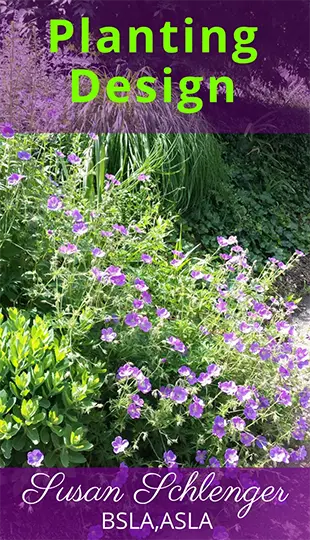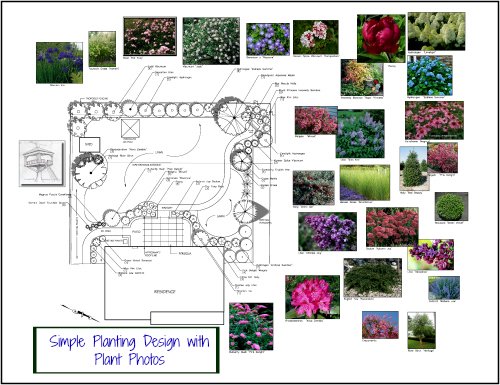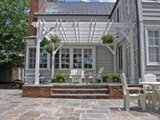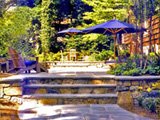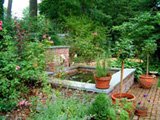Paver Patio Designs
Adding Creative Features
Paver patio designs are extremely popular. They are not too expensive and are easy to install.
Yet, what makes a paver designs for patios different than those for either a driveway or a walkway?
There are a few answers to this question.
First of all, a patio is a place where you most likely will be spending a fair amount of time. It is an outdoor living space, not an area that you are passing through, such as landscape walkways or driveways.
In addition, paver patio designs are typically an integral part of the overall landscape design. It's not that walkways or driveways are not important.
They are very important, but there are less creative elements to
add to these outdoor hardscapes. You wouldn't add a seat wall to a
driveway nor would you add a circle kit design to a walkway.
Pavers Can Be Boring!
All elements of landscape design should be to scale, and this is true for patio paver designs too. Due to the fact that patios have a rather large field of pavers, the paver patterns, colors and details must be thought out carefully as they will have a large impact on the total landscape design. In addition, it is a challenge to create and interesting paver patio design and avoid monotony.
For
example, paver patterns of small pavers, such as a small, three sized
cobble design, or even your typical brick shaped paver, used as the
complete design on a large patio can easily become tedious. There are no
breaks...just a sea of pavers.You can see some uniques patio designs
and features in my ebook on patio plans.
Paver Patio Circle Kit Designs
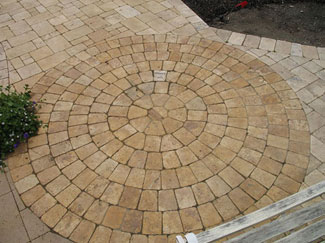
A circle design can be added to the center of the patio, or even to a prominent corner.
This is a circle of pavers radiating outward within the patio design.
Once again, it can be the same color as the rest of the patio pavers, where the circle itself creates the interest, or the circle may be a different color.
You can even make the circle the same color and place a circular border in another color around the perimeter of the circle.
Paver Patio Borders
One of the ways to add interest to pavers is to add a double soldier course around the perimeter of the patio.
This is simply two rows of one of the paver sizes laid parallel or perpendicular to the edges so as to form a border. Thus your eye has someplace else of interest to look.
- This border may be the same color as the rest of the patio.
- The border color may be slightly different, blending well
- It can be a contrasting color.
Patio Seat Walls
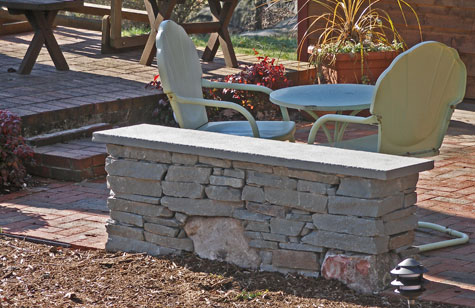
Seat walls are another feature which will add interest to the overall paver design. These can be created out of coordinating block, often available from the paver company, or it might be made of natural stone.
If
choosing stone, be sure to coordinate the stone size and color with
your paver selection. Bluestone often goes well with many paver colors.
Paverart
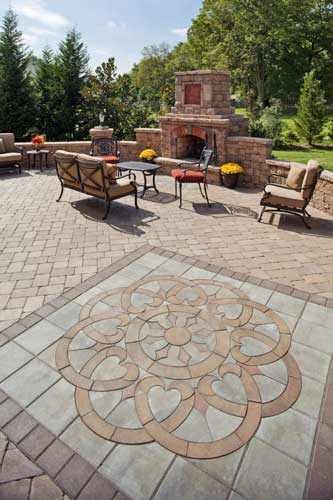
- There is also something call Paverart. Here, an actual patio paver
design, like artwork, can be inserted into the patio design.
- Paverart offer both stock and custom designs.
- They have many standard designs that you can easily use, or if you want to get more creative, they will design something for you based on what you tell them.
- Imagine creating a custom design of your house number, your hobby, beautiful artwork, or even your dog!
You can use colors that blend with the rest of your pavers, or you can use contrasting color to make the design really pop!
Patio Pavers - To The House...Or Not?
Paver patio designs and the pavers themselves do not have to extend directly up to the house. You can create a planting bed, softening the space between the patio and home. Flowering vines look great, if you are not opposed to having them grow on your home.
You can also be very daring, and leave out a few of the pavers. In their place, plant low growing plants, such as Thyme or Sedum. Both of these plants grow in dry conditions, so they are suitable to use in this way. Occasional watering will be needed.
You might also consider an outdoor
pergola for shade. This adds lovely architecture to an otherwise flat
surface. It provides shade and can be designed to be just part of the
patio or it can be a covering over the entire outdoor living space.
Some
well known paver suppliers are Belgard, Cambridge, Techo-Bloc, and
Eagle Bay. They each offer their own paver patterns, textures and
colors, although many are similar. Match your pavers to your house
material, house color and also to any other existing hardscape in your
landscape design.

Patio Plans For Inspiration.
See actual patio plans that I did for some of my clients. Both 3D and
plan view designs are shown so that you can use them or get ideas for
your own project. Explanations are also provided.
Related Pages:
concrete pavers
paver patio designs and pictures
If you enjoyed this page, please share it!
Popular Pages
